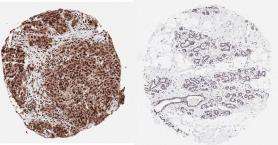Newly Discovered Protein Function Linked to Breast Cancer

(PhysOrg.com) -- UA researchers participated in the discovery of an unexpected role played by a protein molecule, making it a candidate for a biomarker or drug target for breast cancer.
University of Arizona researchers are part of an international team that has discovered a new cellular mechanism that is associated with the development of breast cancer.
Identifying and understanding novel components of signaling networks, the scientists say, are likely to reveal new therapeutic targets for personalized medicine.
"This could be a tool for staging breast cancer biopsies or serve as a prognostic marker," said Sourav Ghosh of the UA College of Medicine - Phoenix. "But more studies will be required to establish these connections more firmly."
Team members made their discovery by looking in unlikely places. They discovered a novel component of an important cellular signaling network known as the NF-kB pathway. A known protein called Rap1, they found, performs tasks in parts of the cell where, according to conventional wisdom, it was not supposed to be.
A group led by Ghosh found that Rap1 interacts with the NF-kB pathway in breast cancer cells, in addition to its known function inside the cell nucleus.
Their results show that the previously unrecognized function of Rap1 protein in the NF-kB network can contribute to the pathology of breast cancers.
The researchers report their findings in the advance online publication of the Nature Cell Biology July issue.
The cells in our bodies constantly sense their environment and respond appropriately. For example, if pathogens invade the body, cells will respond by generating an inflammatory environment to fight the pathogen. This is achieved by intricate molecular circuits within cells that sense and relay external signals and orchestrate the cellular response. Aberrant functioning of these cellular switch boards can lead to diseases including autoimmune disorders and cancer.
In the study, an the scientists set out to better understand the molecular workings underlying inflammation. Inflammation, the body's primary line of defense against disease-causing microbes and parasites, is a highly complex and tightly regulated biochemical process involving a myriad of specialized cells communicating with each other through an arsenal of signaling molecules.
The team systematically screened 17,000 genes to single out those that interact with the NF-kB protein complex and activate the inflammation pathway.
NF-kB, which stands for "Nuclear Factor Kappa B," can be thought of as a major hub in the biomolecular pathways involved in the inflammation response.
The NF-kB protein is part of the molecular inventory of almost every cell type, where it acts as a multifunctional switch, binding a variety of other specialized molecules exchanging signals between the cell's surface and the genetic material inside the nucleus.
The central importance of NF-kB for inflammation, autoimmune diseases and cancer makes it one of the most studied molecules and one of very few to which entire scientific meetings are dedicated.
"Surprisingly, we found Rap1 outside the cell nucleus and as part of the NF-kB signaling pathway," said Ghosh, who was involved in planning and executing the cancer research aspect of the study.
Ghosh is an assistant professor at the UA College of Medicine - Phoenix and a member of the Arizona Cancer Center. He also is an adjunct associate investigator at the Translational Genomics Research Institute, or TGen, in Phoenix. His group was comprised of researchers at TGen and Barrow Neurological Institute/St. Joseph’s Hospital in Phoenix.
Prior to the discovery, scientists believed that Rap1 was limited to structures at the ends of chromosomes. Tucked inside the cell nucleus, chromosomes consist of tightly wound threads of DNA that carry an organism's genetic information.
In contrast to its original role, in which Rap1 has been found to stabilize the ends of the chromosomes, scientists still have to figure out what the protein is doing when it is outside the nucleus.
"The exact role of NF-kB in cancer is not well understood, but our study sheds a little bit of light on it," Ghosh said. "Rap1 and NF-kB activity drive each other in a positive feedback loop. Since NF-kB signaling is hyperactive in breast cancer cells, we think that Rap1 might be one of the factors contributing to that hyperactivity."
His group found increased Rap1 levels in tissue samples of breast cancer cells of the more common types, the ductal and lobular carcinomas. Most importantly, Ghosh and his coworkers discovered that higher grade tumors had higher levels of Rap1.
More information: Telomere-independent Rap1 is an IKK adaptor and regulates NF-κB-dependent gene expression. Nature Cell Biology, July 2010. www.nature.com/ncb/journal/vao … nt/full/ncb2080.html
Provided by University of Arizona
















